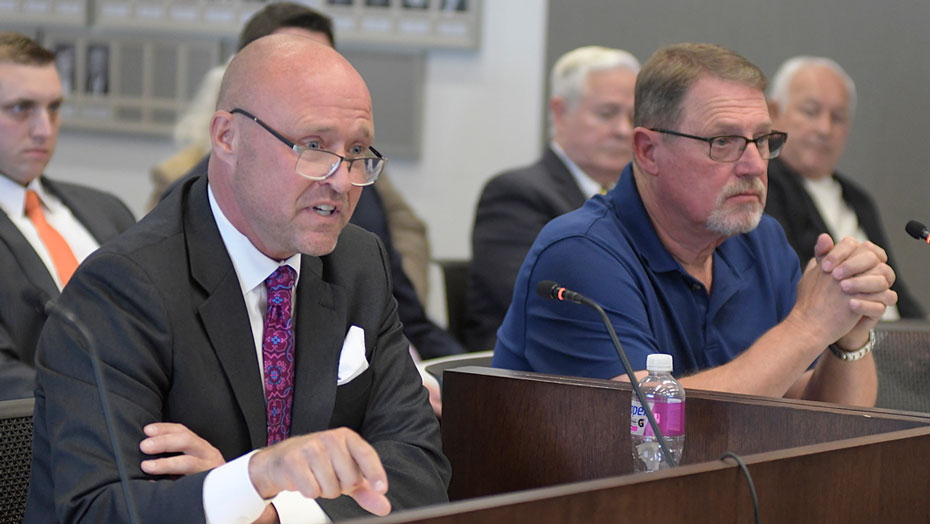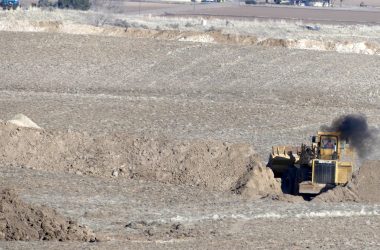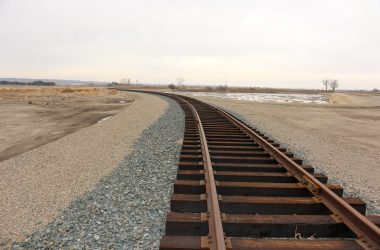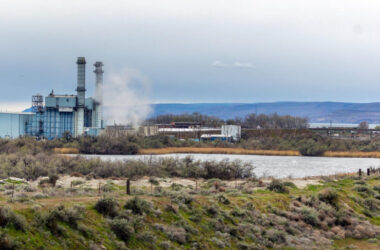
Greg Smith (left) Malheur County economic development director and Larry Wilson, Malheur County commissioner, testified before the Oregon Transportation Commission last week. Both men urged the commission to support a proposal to build a rail reload center north of Nyssa. (Mark Ylen, Mid-Valley Media).
SALEM – State transportation officials appeared ready to reject a plan to build a rail reload facility north of Nyssa last week, but agreed to give supporters of the venture one more chance to plug lingering gaps in the proposal.
The Oregon Transportation Commission voted Thursday to extend the deadline on a final decision for the $26-million-dollar rail reload facility until July 18.
By then, state officials want supporters of the project to provide information regarding the cost of rail service, shipping prices and costs, an updated business plan and confirmation the center will carry a sustainable customer base. The commission also directed the Transportation Department to craft a list of questions for the local reload center and three similar projects in the Willamette Valley. Supporters of all three projects will then have until Friday, July 12, to furnish their answers. The proposed Nyssa rail facility – in the works for more than three years – appears to be on life support.
Neither Mike Garrett, director of the state Transportation Department or Tammy Baney, the chair of the commission, felt comfortable giving a green light to the project. Garrett told the Transportation Commission that he couldn’t recommend “advancing any of the three projects.”
“It became apparent to me that there does indeed remain deficiencies where information is just lacking or information is not specific enough or dated,” said Garrett.
Baney said if the commission was “pushed to make a decision today it would be no.”
Several commission members also questioned specifics of the Nyssa venture.
Greg Smith, Malheur County economic development director, and Larry Wilson, Malheur County commissioner, testified to the commission in favor of the Nyssa facility Thursday.
“There is tremendous support and enthusiasm, not just in Malheur County, but across the river (in Idaho) as well. I think they are looking toward us and want to utilize our center,” Wilson told the commission.
Smith also assured the commission that local residents want the facility.
But consultants hired by the transportation commission to review the proposed Nyssa facility told the commission that some important questions remain unanswered. Dan Smith, with The Tioga Group, a Pennsylvania-based consulting firm, told the commission railcar availability for the facility is still an issue.
“They have to provide their own rail cars and as yet there is no provision for doing that and the cost is unknown at the moment,” said Smith.
The consultant said the railcar issue is a “major gap for the Treasure Valley proposal.”
Smith also told the commission that the Nyssa rail center will offer manifest – or basic – service for shippers.
“That’s basically the same as Treasure Valley shippers already have,” said Smith.
Initially, supporters of the Nyssa project touted the facility as a way to ship onions and other commodities to east coast markets faster.
Greg Smith told the commission that Malheur County has been “in communication” with AmeriCold Logistics LLC, a major transportation firm based in Georgia.
“We can contract with them as paid consultants to assist in the design of the facility. And we’ve reached out to Cryo-Trans for rail car availability,” said Smith. Cryo-Trans Inc. is a Maryland company that leases mechanically refrigerated and insulated rail cars.
Smith said county officials had “reached out to our primary onion folks” about whether the Nyssa facility will work for them.
“They came back and said yes,” said Smith.
Commission member Martin Callery told Smith he was concerned there are rail facilities already in place in the county that would fulfill the same purpose – shipping onions – as the Nyssa center.
“My question is have you looked at the capacity that already exists for the shipments of this type of commodity without this level of investment?” asked Callery.
Smith said those existing facilities are “privately owned.”
“And yet we have shippers and growers who are just as important to the county court and to the citizens of Malheur County that are not located on the UP (Union Pacific) main line who are having to ship their commodities, as we have heard, to Washington or to Salt Lake or to locations in Idaho,” said Smith.
He said the Nyssa facility would “provide a public resource managed by the private sector, but public resources that all our shippers and growers can utilize.”
He said it will ensure that “those who aren’t on the UP main line can utilize the service in the county and not have to take their products out of state.”
Bruce Carswell, senior vice president for the Oregon Eastern Railroad in Vale, said Friday his firm offers the same type of service as the proposed Nyssa center.
“We’re always actively recruiting new customers who are growers and shippers,” said Carswell.
Carswell said his company has to “provide equal access to those who want to use that service.”
“So, it’s not like we can exclude farmer A and just work with farmer B,” said Carswell.
With the deadline on a final decision looming next month a key question is what are the county’s next steps. So far, that remains a mystery.
Dan Joyce, Malheur County judge, and other supporters of the project didn’t respond to questions from the Malheur Enterprise Friday. Smith also didn’t respond to questions about the next steps.
The rail center can trace its roots to the 2017 passage of a massive state transportation bill by the Oregon Legislature.
In September 2018, Greg Smith delivered a plan for the facility to state transportation officials that consisted of an economic feasibility study, cost estimates and a site blueprint.
In December, Smith said he anticipated the money for the project would be released and construction would begin in spring.
The project stalled in February when the Transportation Commission raised an array of questions about whether the center was economically sustainable.
The commission was slated to make a final decision on the reload project in March but instead set new deadlines – in April and May – for the development corporation to answer its questions.
Union Pacific pledged service to the facility in May but said it could not furnish express shipping or provide railcars. The railroad firm also said it may not be able to ship commodities during peak times.
From the record
During last week’s meeting of the Oregon Transportation Commission, Malheur County officials faced questions about the unexpected cost of leasing railcars to serve the onion industry. Here is the transcript of an exchange between the vice chair of the commission and Greg Smith, Malheur County’s economic development director. The reference to return-on-investment turns on the state’s expectation that each dollar of state money invested in a rail project will return $1 dollar in benefit to the public.
Robert Van Brocklin: One is around return on investment. So I think what I read was that the project plan was an ROI of 1 to 1. But I didn’t note right in there anything about rail car costs.
So I wonder since we are obviously focused on a question not just with respect to your proposal but with all proposals about what is, do we have a positive return on investment over time and over what period of time…I think I’m correct that the ROI of 1 to 1was predicated on not including rail car costs and those obviously would change that presumably. Could you talk me through the ROI of this project?
Greg Smith: First of all I want to refer to Commissioner (Larry) Wilson’s comments and recognize that the reload development that we are discussing is in an area of high poverty and limited economic opportunity. So I want to be very clear for those who are thinking return on investment as it relates to real estate growth, etc.
What I would share with you is that we retained ECONorthwest. We asked them to take a look at this project and to run that scenario for us.
They, when it was all said and done, really came back with a couple thoughts, one was this was going to provide an opportunity for Malheur County growers and shippers to not be crossing over the Blue Mountains to get to Walla Wal– the Wallulas, Pasco area, thereby creating less depreciation on the railroad, less carbon in the air and greater efficiency for folks at home.
That was number one.
Number two, again our goal on this facility is to not have debt. And so that return on investment, if we can maintain that relationship to where we have someone else carry that liability, while that return on investment may be a long-term increase, we think we’re going to be able to keep it from declining.
The goal on this is to have no debt. And so, uh, really the return to the state of Oregon is one, is reduced truck traffic between Nyssa and Washington and parts of Idaho and Utah.
And I would share with you, I would have your region 5 manager up and ask relieving truck traffic between Ontario and Baker City is that important. I think you’d find the answer on that is yes, and again reduced carbon and reduced tear on those highways.
SUBSCRIBE TO HELP PRODUCE VITAL REPORTING — For $5 a month, you get breaking news alerts, emailed newsletters and around-the-clock access to our stories. We depend on subscribers to pay for in-depth, accurate news produced by a professional and highly trained staff. Help us grow and get better with your subscription. Sign up HERE.




